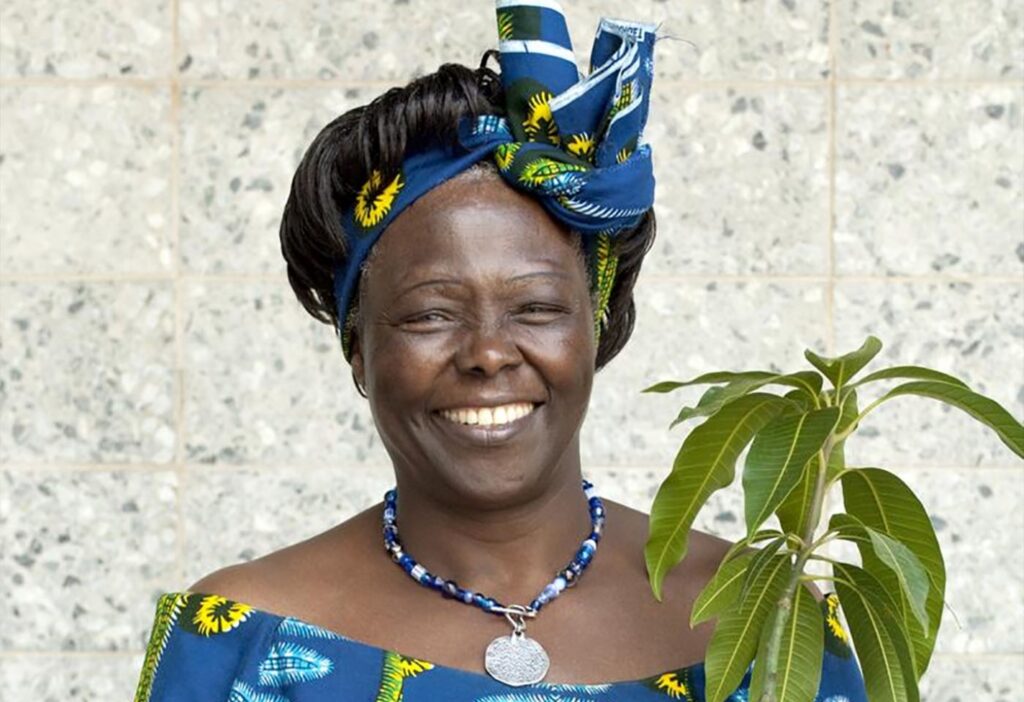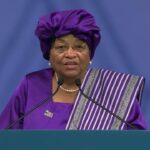Wangari Maathai was a Kenyan environmental, and political activist and the first African woman to win the Nobel Peace Prize. She founded the Green Belt Movement, an environmental non-governmental organization focused on the planting of trees, environmental conservation, and women’s rights. Maathai is also an academic and intellectual with significant contributions to ecology, development, gender, and African cultures and religions. She is the first woman in East and Central Africa to become a Doctor of Philosophy, receiving her Ph.D. from the University of Nairobi in Kenya. Here is the story of Wangari Maathai and some of her phenomenal achievements.
Early life and education
Wangari Maathai was born on 1 April 1940 in the village of Ihithe, Nyeri District, in the then colony of Kenya. She attended Ihithe Primary School and then moved to St. Cecilia’s Intermediate Primary School at the age of 11. She completed her primary studies in 1956 and was granted admission to Loreto High School, Limuru, the only Catholic high school for girls in Kenya.
Thanks to the Kennedy Airlift program, Maathai became one of some 300 Kenyans selected to study in the United States in September 1960. She received a scholarship to study at Mount St. Scholastica College, in Atchison, Kansas, where she majored in biology, with minors in chemistry and German.
After receiving her Bachelor of Science degree in 1964, she studied at the University of Pittsburgh for a master’s degree in biology. In January 1966, Maathai received her MSc in biological sciences and was appointed to a position as research assistant to a professor of zoology at the University College of Nairobi.
Upon returning to Kenya to start her new job, she was informed that it had been given to someone else. Maathai believed this was because of gender and tribal bias. She however later got a job as a research assistant in the microanatomy section of the newly established Department of Veterinary Anatomy in the same University College.
In 1967, she traveled to the University of Giessen in Germany in pursuit of a doctorate. She studied both at Giessen and the University of Munich and returned in 1969, to continue her job at the University College of Nairobi as an assistant lecturer. In 1971, she became the first Eastern African woman to receive a Ph.D., her doctorate in veterinary anatomy, from the University College of Nairobi.
Early Activism
Wangari Maathai continued to teach at Nairobi, becoming a senior lecturer in anatomy in 1975, chair of the Department of Veterinary Anatomy in 1976, and associate professor in 1977. She was the first woman in Nairobi appointed to any of these positions. During this time, she campaigned for equal benefits for the women working on the staff of the university, going so far as trying to turn the academic staff association of the university into a union, to negotiate for benefits. The courts denied this bid, but many of her demands for equal benefits were later met.
In addition to her work at the University of Nairobi, Maathai became involved in several civic organizations in the early 1970s. She was a member of the Nairobi branch of the Kenya Red Cross Society, becoming its director in 1973. She was a member of the Kenya Association of University Women. Following the establishment of the Environment Liaison Centre in 1974, Maathai was asked to be a member of the local board, eventually becoming board chair. She also joined the National Council of Women of Kenya (NCWK).
Through her work at these various volunteer associations, it became evident to Maathai that the root of most of Kenya’s problems was environmental degradation. In a bid to tackle these environmental problems and limit the rising unemployment in Kenya Maathai founded Envirocare Ltd., a business that involved the planting of trees to conserve the environment, involving ordinary people in the process. Envirocare ran into multiple problems, primarily dealing with funding, and ultimately failed. However, she was able to achieve certain successes such as attending the first UN conference on human settlements, known as Habitat I, in June 1976 and marking World Environment Day, with the NCWK.
Green Belt Movement
Wangari Maathai founded the Green Belt Movement in 1977 in response to the environmental concerns raised by rural Kenyan women. The Movement partnered with the Norwegian Forestry Society. It had also received “seed money” from the United Nations Voluntary Fund for Women. These funds allowed for the expansion of the movement, for hiring additional employees to oversee the operations, and for continuing to pay a small stipend to the women who planted seedlings throughout the country. It allowed her to refine the operations of the movement, paying a small stipend to the women’s husbands and sons who were literate and able to keep accurate records of seedlings planted.
The UN held the third global women’s conference in Nairobi. During the conference, Maathai arranged seminars and presentations to describe the work the Green Belt Movement was doing in Kenya. She escorted delegates to see nurseries and plant trees. The conference helped to expand funding for the Green Belt Movement and led to the movement’s establishing itself outside Kenya.
In 1986, with funding from UNEP, the movement expanded throughout Africa and led to the foundation of the Pan-African Green Belt Network. Forty-five representatives from fifteen African countries traveled to Kenya over the next three years to learn how to set up similar programs in their own countries to combat desertification, deforestation, water crises, and rural hunger. The attention the movement received in the media led to Maathai’s being honored with numerous awards.
Read More:
- Constance Markievicz: The First Woman Elected Into The British Parliament
- Ellen Johnson Sirleaf: First Female President In Africa
- Vigdis Finnbogadottir: First Female President In The World
Clash With The Kenya government
In 1988, the Green Belt Movement carried out pro-democracy activities such as registering voters for the election and pressing for constitutional reform and freedom of expression. The single-party regime opposed many of the movement’s positions regarding democratic rights. In order to stop the progression of the movement, the government invoked a colonial-era law prohibiting groups of more than nine people from meeting without a government license.
In October 1989, Maathai learned of a plan to construct the 60-storey Kenya Times Media Trust Complex in Uhuru Park. She wrote many letters in protest to, the Kenya Times, the Office of the President, and concerned national and international bodies. The government refused to respond to her inquiries and protests, instead responding through the media that Maathai was “a crazy woman. The government audited the Green Belt Movement in an apparent attempt to shut it down. Despite the government’s efforts, her protests and the media coverage the government’s response garnered led foreign investors to cancel the project in January 1990.
Maathai was arrested alongside other members of the pro-democracy group, known as the Forum for the Restoration of Democracy (FORD), after revealing that they were targeted for assassination, that a government-sponsored coup was possible, and called for a general election. They were charged with spreading malicious rumors, sedition, and treason. After a day and a half in jail, they were brought to a hearing and released on bail. The Kenyan government however dropped the charges after numerous pressure from the United States and a variety of international Organizations.
Political Career
During the first multi-party election of Kenya, in 1992, Maathai strove to unite the opposition and for fair elections in Kenya. However the opposition did not unite, and the ruling KANU party used intimidation and state-held media to win the election, retaining control of parliament. The following year, ethnic clashes occurred throughout Kenya. Maathai believed they were incited by the government, who had warned of stark consequences to multi-party democracy. Maathai traveled with friends and the press to areas of violence in order to encourage them to cease fighting.
During the elections of 1997, Maathai again wished to unite the opposition in order to defeat the ruling party. In November, less than two months before the election, she decided to run for parliament and for president as a candidate of the Liberal Party. Her intentions were widely questioned in the press; many believed she should simply stick to running the Green Belt Movement and stay out of politics. On the day of the election, a rumor that Maathai had withdrawn from the election and endorsed another candidate was printed in the media. Maathai garnered few votes and lost the election.
Maathai again campaigned for parliament in the 2002 elections, this time as a candidate of the National Rainbow Coalition, the umbrella organization that finally united the opposition. On 27 December 2002, the Rainbow Coalition defeated the ruling party, and in Tetu Constituency Maathai won with an overwhelming 98% of the vote. In January 2003, she was appointed Assistant Minister in the Ministry for Environment and Natural Resources and served in that capacity until November 2005. She founded the Mazingira Green Party of Kenya in 2003 to allow candidates to run on a platform of conservation as embodied by the Green Belt Movement.
2004 Nobel Peace Prize
Wangari Maathai was awarded the 2004 Nobel Peace Prize for her “contribution to sustainable development, democracy and peace. Between 1901 and 2018, only 52 Nobel Prize awards were given to women, while 852 Nobel Prize awards have been given to men. Through her significant efforts, Wangari Maathai became the first African woman, and the first environmentalist, to win the Nobel Peace Prize.
The Norwegian Nobel Committee, in a statement announcing her as the 2004 Nobel Peace Prize winner stated that ” Maathai stood up courageously against the former oppressive regime in Kenya. Her unique forms of action have contributed to drawing attention to political oppression—nationally and internationally. She has served as an inspiration for many in the fight for democratic rights and has especially encouraged women to better their situation”
Later days and Death
On 28 March 2005, Wangari Maathai was elected the first president of the African Union’s Economic, Social, and Cultural Council and was appointed a goodwill ambassador for an initiative aimed at protecting the Congo Basin Forest Ecosystem. In 2006, she was one of the eight flag-bearers at the 2006 Winter Olympics Opening Ceremony. She was awarded an honorary doctorate by and gave the commencement address at Connecticut College in the same year.
In August 2006, Maathai met with the then-United States Senator Barack Obama, who traveled to Kenya. She and the Senator met and planted a tree together in Uhuru Park in Nairobi. In November 2006, she spearheaded the United Nations Billion Tree Campaign. Maathai was one of the founders of the Nobel Women’s Initiative along with sister Nobel Peace laureates Jody Williams, Shirin Ebadi, Rigoberta Menchú Tum, Betty Williams, and Mairead Corrigan Maguire.
In 2009, Maathai published “The Challenge for Africa” with her insights into the strengths and weaknesses of governance in Africa, her own experiences, and the centrality of environmental protection to Africa’s future. She was named as one of PeaceByPeace.com’s first peace heroes in the same year. Until her death in 2011, Maathai served on the Eminent Advisory Board of the Association of European Parliamentarians with Africa (AWEPA).
Wangarĩ Maathai died on 25 September 2011 of complications arising from ovarian cancer while receiving treatment at a Nairobi hospital. Her remains were cremated and buried at the Wangari Maathai Institute for Peace and Environmental Studies in Nairobi.





